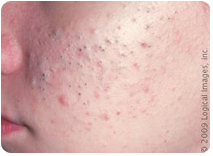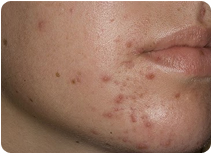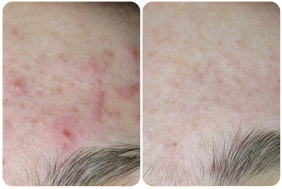Acne, oily skin
ACNE
Acne does not only appear during adolescence but can also be constant companion of adults. Cosmetic preparations can help in getting a grip on it.
How does acne develop? Acne is caused by cornification disorders (keratoses) on the orifices of the sebaceous glands but also by sebaceous hyperplasia, inflammatory alterations and bacterial infections. Follicular hyperkeratosis in the context of acne usually has hormonal causes. Consequently there are typical phenotypes such as pubertal, preovulatory, premenstrual acne and acne after pregnancy.
Acne in adults (acne tarda) occurs after 30 and is also hormonally controlled. It is characterized by dry and scaly skin while pubertal acne shows moist and oily skin. These distinctions should be considered when selecting the appropriate skin care. Skin care preparations for the treatment of the different types of adolescent acne should be low-fat formulations and in the case of very oily skin the cream can be omitted. In these cases, the active agents and sera are applied in pure form. The same applies for the oily skin of older men when pale yellow comedones develop on front and cheeks.


The effects of nutrition
Dietary habits can intensify the genetic and psychogenic disposition to acne. Relatively high carbohydrate consumption does not only affect the skin structure, just to mention the keyword glycation in this context, but obviously also influences the intensity and the progression of acne. The same applies for a nutritional imbalance in fatty acids or in other words, for disproportions between saturated and essential fatty acids and between omega-6 and omega-3 unsaturated fatty acids. Overweight individuals who reduce their calorie intake also reduce the androgen and sebum production. Side effects of pharmaceutical drugs as for instance of hormone preparations and contraceptives are another source of problems.
Comedogenic substances
Comedogenic substances in cosmetic preparations are a frequently discussed topic. What often is overlooked in the process is that it is not the substance as such but rather the physical properties dependent on the respective concentration that can turn the balance. Typical examples are saturated lipophilic compounds such as stearic acid ("stearate creams") and cetyl alcohol with melting points, that exceed the skin temperature, in high concentrations. In low concentrations the comedogenicity is rather low or even non-existent. The situation is different with substances that form aggressive peroxides under the influence of atmospheric oxygen and radiation. Among them are:
- Ethoxilated alcohols and polyethylene glycols (PEG). They are used as emulsifiers, humectants, consistency or film-forming agents and classified as the triggers of the so-called "Majorca acne".
- Essential oils and perfumes. Example: ascaridole (peroxide) of tea tree oil.
A further group is represented by lipophilic cream components such as paraffin oils, vaseline and mineral waxes. They form films on the skin surface which facilitate the growth of anaerobic bacteria such as propionibacterium acnes. The situation is quite similar with filmogenic long-chained silicones. Lanolin can also play a part in this context particularly when the skin is moist and oily. A prerequisite for the comedogenic activity of the mentioned substances however is the respective disposition of the individual person. By contrast, chlorine acne which is triggered by chlorinated hydrocarbons explicitly has a molecular structural background. Preservatives and disinfectants that contain preservatives belong to this group.

Excess skin care
Besides hereditary dispositions and inadequate composition of cosmetics, excess skin care plays a significant part in the acne formation process. Sebumetric measurements conducted by the author on a routine base on the occasion of cosmetic trade fairs showed that the skin of every other female visitor was overloaded with lipid substances or in other words, the measured data were at the upper limit of the measuring range. The measured values included the natural sebum and the lipid substances of the skin care preparations. Consequently, a 50 percent reduction of the amount of the products applied already is a simple and effective measure to prevent compromised skin with the additional benefit that it saves money and is less counterproductive with regard to the physiological conditions of the skin. The living conditions for facultatively pathogenic and anaerobic acne bacteria thus are considerably constrained.
Preventive skin care
Already the dermatological therapy should use cream bases that not only can integrate pharmaceutical active agents such as antibiotics, antiseptics and vitamin A acid (recovery) but also are formulated to match with the individual skin conditions. Unfortunately, white Vaseline, PEGs and preservatives still belong to the ingredients of prescribed pharmaceutical cream bases for acne patients.
It also is desirable that base creams are not changed when proceeding from medical therapy to cosmetic preventive measures. In case that dermatological therapy and skin care are administered at the same time, a close accord also is necessary; it is ideally realized with the adjuvant corneotherapy (combination of pharmaceutical therapy and cosmetic prevention).
It depends on the specific acne type whether keratolytic, anti-inflammatory, antimicrobial active agents are preferred or alternatively, agents that support the recovery of the skin. As already mentioned, fatty cream bases are only beneficial if sparely applied on dry skin. Pure active agent concentrates and their combinations have priority.
Keratolytic substances
- Salicylic acid and willow bark extracts have keratolytic but also antimicrobial effects.
- Higher concentrations of urea break up the hydrogen bridge bonds between the corneocytes.
- α-Hydroxy acids (AHA fruit acids) such as lactic acid, glycolic acid and citric acid have keratolytic and regenerating effects, however should be administered in exceptional cases only as they excessively strain the skin on the long term and finally contribute to its aging process. Free ascorbic acid (vitamin C) has similar effects.
- Papaya and pineapple extracts are ingredients of enzyme peelings. They contain the enzymes papain respectively bromelain which belong to the proteases that can break down proteins.
Anti-inflammatory substances
- [Keto-] boswellia-acids gained from frankincense resin inhibit the skin’s own proteases and 5-lipoxygenase. The endogenous enzyme is responsible for the formation of the inflammation triggering leukotrienes LTA4, LTB4, LTC4, LTD4 and LTE4.
- Linoleic acid (omega-6 fatty acid) is converted into the anti-inflammatory 13-hydroxy-9,11-octadecadienoic acid by 15-lipoxygenase which is another significant enzyme of the skin. The essential fatty acid is contained in a number of native oils and in phosphatidylcholine (see below).
- Evening primrose oil contains gamma-linolenic acid (omega-6 fatty acid) which is oxidized in the skin into 13-hydroxy-6,9,11-octadecatrienoic acid.
- Linseed oil contains more than 55% and kiwi seed oil more than 60% of alpha-linolenic acid (omega-3 fatty acid) which, through 15-lipoxygenase forms the anti-inflammatory 13-hydroxy-9,11,15-octadecatrienoic acid.
- Ribwort (also buckthorn, ribgrass among others) extract contains the anti-inflammatory acetoside.
- Berberine is an alcaloid and occurs in the barberry (also berberis) extract. It has anti-inflammatory and antiseptic effects.
- Active agents of chamomile
- Astringent extracts of witch hazel and green tea
- Zinc salts - preferably in liposomal form
Antimicrobial substances
- Azelaic acid is a 5-alpha-reductase inhibitor and specifically affects propionibacterium acnes. Required is a liposomal application of up to 1% of the active agent. Higher concentrations only are licensed in pharmaceutical drugs.
- High-proof alcohol serves for disinfection and purification purposes; the same applies for isopropyl alcohol.
- Algae extracts and masks
- Betulinic acid
Regenerating substances
- Vitamin A and its esters: Attention should be paid to the dosage for sensitive and Asian skin since the irritation threshold is fast reached due to the formation of vitamin A acid in the skin.
- Niacinamide (vitamin B3)
- Vitamin E and its esters
- Vitamin C esters, particularly sodium ascorbyl phosphate (INCI), take full effect after enzymatic cleavage
- Red clover and soybean phytohormones have light estrogen-like effects on the treated skin areas due to their high content of isoflavones.
- Echinacea extract (also sun hat, coneflower, sun bonnet)
- Yeast extract, its effect is mainly based on its content of B-vitamins
- D-panthenol
Phosphatidylcholine
Phosphatidylcholine (PC) is a multifunctional natural substance and should be an integral part of the skin care program for acne affected persons. A multicentric clinical study based on a half-side test with application of a PC containing liposome concentrate (without additional active agents) on acne vulgaris 1nd and 2nd degree shows a comedone reduction of 65% within a period of 4 weeks. PC is rich in linoleic acid (see above), fluidizes both skin barrier and sebum and also is effective in other keratoses. In addition, the sebum secretion in oily skin is reduced, a recovery of the skin is observed and the remaining acne scars are improved or in other words, indurations are smoothed.
Liposomal and nanoparticular dispersions with PC form aqueous sera without counterproductive oily character even in the case of the above mentioned vegetable oils with their essential fatty acids. Hence PC is the ideal carrier substance for hydrophilic and lipophilic active agents.
Complementing preparations
- Adequate preparations for the cleansing of acne-affected areas are pH neutral preparations without re-fatteners but formulated with surfactants of low irritation potential. Eventually also liposomal lotions can be applied which simultaneously have cleansing and skin-caring effects.
- Make-ups (foundations, powders) should allow the skin to breathe and beyond that comply with the same requirements as mentioned above for cream bases.
- The treatment of acne scars is effected by dermabrasion, grinding, dermal needling, cryopeeling and injections (funnel-shaped scars). Enzymatic or abrasive body enriched peelings, regenerating active agents such as vitamin A, vitamin C phosphate, essential fatty acids, phosphatidylcholine and measures to support the microcirculation and elasticity (caffeine, green tea, local massages) appertain to the preparative repertory.
Recipes:
|
Acne (oily skin)
|
Reinigungs-gel, Suusmoon®-Lotion P and cream: 44ml DMS®-Basiscreme Classic or:
or: |
|
Ageing acne (dry skin) |
Reinigungs-gel (cleansing gel) или Reinigungsmilch mit DMS (cleansing milk), enzyme peeling mask and cream: 44ml DMS®-Basiscreme High Classic
or:
|
|
Acne during exacerbation period. |
44ml DMS®-Basiscreme High Classic
or PlutioDerm® и Suusmoon®-Lotion P |
|
Acne (scars, the presence of papular elements, post-traumatic hyperpigmentation). |
Reinigungs-gel, Suusmoon®-Lotion P and cream: 44ml DMS®-Basiscreme Classic or PlutioDerm®-gel |